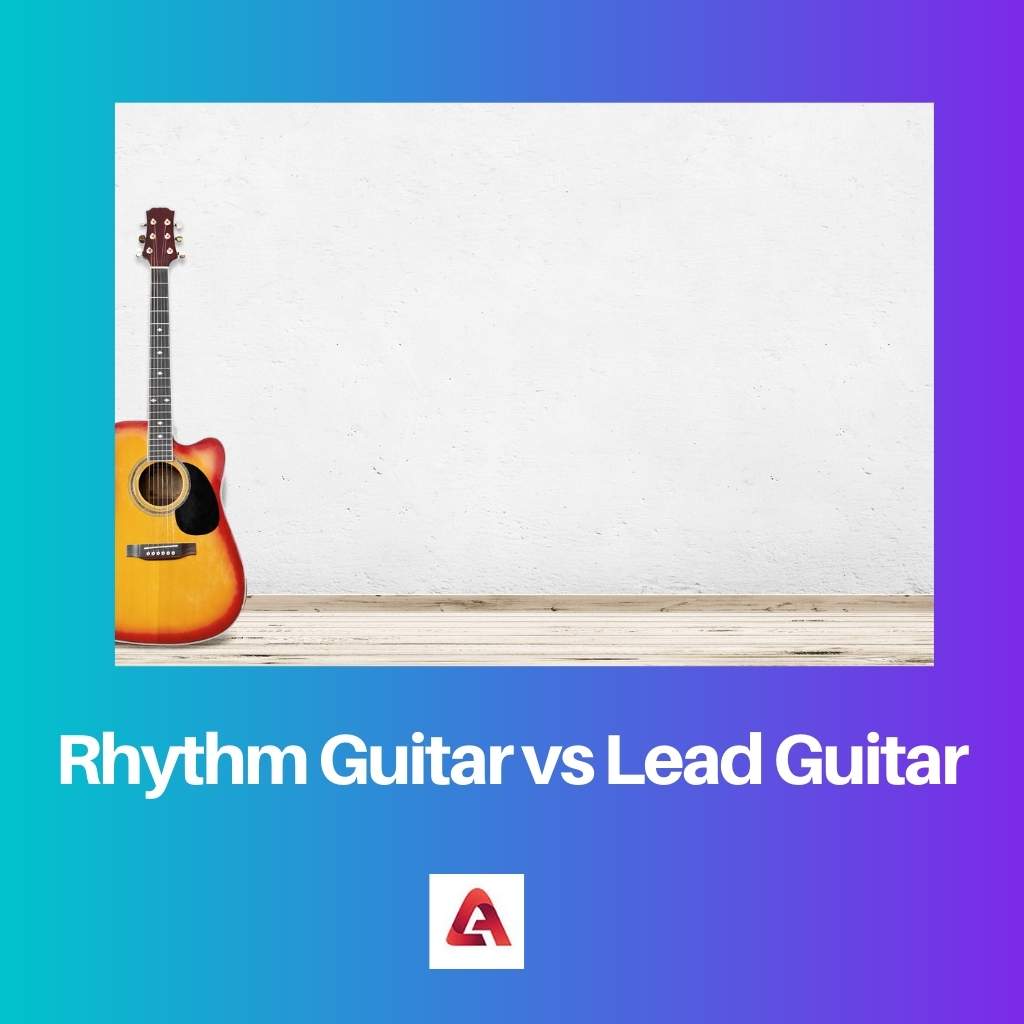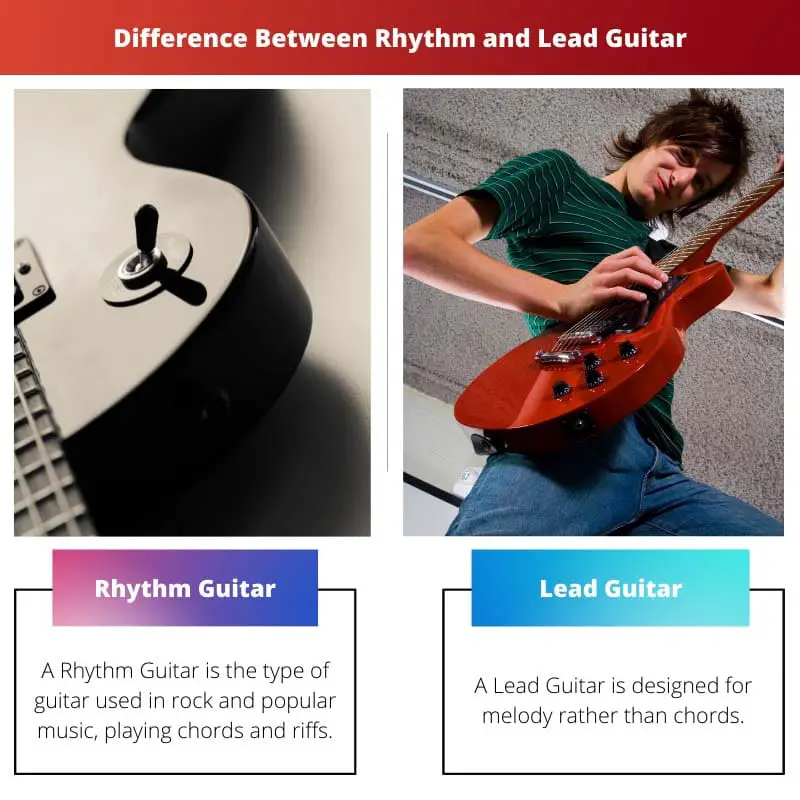Rhythm and Lead Guitar create a pleasant sound that complements each other. However, Lead guitarists are associated with an identifiable sound due to their distinct style.
Rhythm and Lead Guitar can be played harmoniously, making chords with one another. Rhythm and Lead Guitar are immensely similar, yet they are different too.
Key Takeaways
- Rhythm and lead guitar are two roles in a band or musical group.
- Rhythm guitar is responsible for providing a song’s underlying chords and rhythm, while lead guitar is responsible for playing solos and melodies.
- Rhythm guitar plays simpler chord progressions, while lead guitar uses more complex scales and techniques.
Rhythm Guitar vs Lead Guitar
A Rhythm Guitar is a special type of electric guitar that is used to produce sounds in rock and other popular music genres, and it is designed with standard and straight tunings. Lead guitar is the type of guitar used by electric bands, and they’re used by the main artists during solos.

Rhythm guitar is used in rock music and is supported by the use of riffs, where the guitarist plays repeated short phrases along with the song.
Unlike chords, which are played for several bars, a riff lasts only eight before repeating. Moreover, Rhythm Guitars are designed with straight and standard tuning.
Lead guitarists are associated with an identifiable sound due to their distinct style. Lead guitarists are called upon to create the melody of the song by performing the main solo, which showcases their musical talent.
Moreover, Lead Guitars use lower tunings such as Drop D, which provides easier access to higher notes.
Comparison Table
| Parameters of Comparison | Rhythm Guitar | Lead Guitar |
|---|---|---|
| Definition | A Rhythm Guitar is the type of guitar used in rock and popular music, playing chords and riffs. | A Lead Guitar is designed for melody rather than chords. |
| Chords | Rhythm guitars are tuned to dominant chords, which have their roots in Major and Minor scales. | Lead Guitars have tuned up three whole steps. |
| Tuning | Straight and standard tuning. | Lower tunings. |
| Sound-Quality | Rock and popular music. | It is designed for melody. |
| Cost | It is high-priced. | It is low-priced. |
What is a Rhythm Guitar?
The Rhythm Guitar is a class of electric guitars which play chords in regular beats, provided by a solid, plectrum-style pick that produces only the striking notes of the chord.
This style has been widely known as Hawaiian Guitar since it was developed there. Apart from its use with regular chords, it can also be played with barre chords and fingerpicking for a softer sound.
The Rhythm Guitarist strums or plucks open strings to add to the chordal effect. The Rhythms of reggae music are created by bass guitar or drums, with guitar providing accompaniment, and quick chord changes on the Rhythm Guitar keep time.
The Rhythm Guitar is designed with straight, standard tunings that play two power chords to create a pleasant sound that complements each other.
Rhythm Guitars are tuned to dominant chords, which have their roots in Major and Minor scales. Although this means that most chords can be played on a guitar in just one key, Rhythm guitars are tuned down one whole step.
The Rhythm Guitar’s style was much like mainstream jazz, with upright or Western acoustic bass and a smooth, relaxed slip-note technique.

What is Lead Guitar?
Lead Guitar is also known as a rhythm section or simply by the term “guitar” in some cases. While the bass player traditionally played the guitar, Lead Guitar is common with many electric bands.
Lead Guitarists can be expected to play riffs and solos in addition to the heavy rhythms that accompany heavy music.
The term “Lead Guitar” is the most common name for electric guitar. A guitarist may be considered a lead guitarist if they focus on soloing, improvising with the song’s melody, or playing with complex riffs.
Lead guitars are tuned differently than standard guitars because it has higher strings or thinner strings to accommodate these skills.
Lead Guitars are tuned to dominant chords, which have their roots in Minor and Major scales.
However, because of this major scale’s tendency to be unstable and the scale’s key is well outside the usual bass range, it is common for Lead Guitars to drop down two half steps.
Lead Guitars can be played together in harmony and make chords with one another. These chords are the same as the “crashed out” chords that accommodate the Lead Guitarist’s higher range.

Main Differences Between Rhythm and Lead Guitar
- A Rhythm Guitar is the type of guitar used in rock and popular music, playing chords and riffs, whereas, A Lead Guitar differs from a rhythm guitar in that it is designed for melody rather than chords.
- Rhythm Guitars are tuned to dominant chords, which have their roots in Major and Minor scales, whereas, A Lead Guitar is tuned up three whole steps.
- Rhythm Guitars are designed with straight and standard tuning, whereas Lead Guitars use lower tunings such as Drop D.
- A Rhythm Guitar is the type of guitar used in rock and popular music, whereas, A Lead Guitar is designed for melody.
- Rhythm Guitars is high-priced, whereas Lead Guitar is low-priced.

References
- https://hal.inria.fr/hal-03335822/
- https://search.proquest.com/openview/89c0eda72fd6e1b901f19258bd8b0ded/1?pq-origsite=gscholar&cbl=40811

The article offers an informative comparison between rhythm and lead guitars, highlighting the distinct purposes they serve within musical compositions. The comprehensive explanation allows readers to appreciate and distinguish the unique characteristics of each type of guitar.
The detailed descriptions of rhythm and lead guitars provide a comprehensive understanding of their roles in the production of music. The comparison table is especially helpful for visualizing the distinctions between the two.
The in-depth analysis of the sound and style of each guitar type is greatly appreciated. The focus on chord progressions for rhythm guitars and the use of lower tunings for lead guitars help to differentiate their roles and unique sounds.
The comprehensive overview of rhythm and lead guitars, spanning from their functions to their tuning methods and sound characteristics, offers valuable knowledge for both musicians and music enthusiasts. The article’s detailed analysis effectively highlights the distinctions between the two guitar types.
This article provides an excellent analysis of rhythm and lead guitars, elaborating on their unique features, roles, and technical aspects. The detailed breakdown allows for a thorough understanding of the differences between these two fundamental elements of music production.
The comprehensive descriptions of rhythm and lead guitars, including their distinct tunings, sound qualities, and functions within a musical ensemble, offer valuable insight into the roles of each instrument. The explanation of the differences between the two is well-articulated.
The article thoroughly explains the differences between the rhythm and lead guitars, and how each one is used within a band or musical group. The comparison chart and the descriptions are very helpful for those looking to understand these distinctions.
The explanation of rhythm guitar as a foundational element in rock music, complemented by the lead guitar’s melodic role, effectively conveys their respective contributions to musical compositions. The article provides a clear and insightful comparison between the two guitar types.